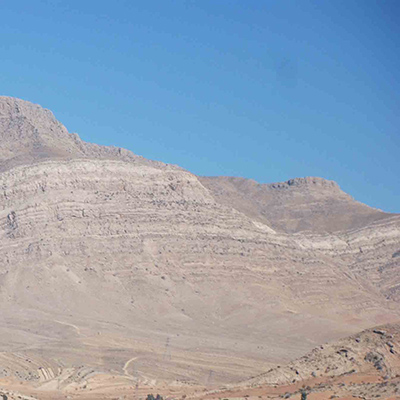Sites
Bamu
Hassan Jafarzadeh
120 Views
Bamu, a border height in the Azgeleh district of Salas-e Babajani County, Kermanshah Province, was occupied by the Iraqi army at the onset of the Iran-Iraq War. Located at 34°54’ N and 45°46’ E, Bamu Mountain runs along a north-south axis parallel to the Iran-Iraq border. It spans 15 km in length and 5 km in width in the Azgeleh district of Salas-e Babajani County in the northwestern part of Kermanshah Province. Part of the Zagros Mountain range, it lies between the Dari Zanganeh River and the Sartak Pass, with its highest peak in Iran reaching 1847 meters above sea level.[1] The Bamu Height forms part of the Iran-Iraq border, with the borderline running along the southern and eastern ridgelines, dividing it into two parts, of which the larger and higher is located in Iraq.[2]
Before the Iran-Iraq War, Bamu, along with other border heights, served as Kermanshah Province’s first defensive line against Iraqi potential attacks.[3] Given the area’s strategic significance, the Iraqi army reinforced its presence by deploying a mechanized battalion from Khanaqin towards Bamu Mountain (positioned opposite Iran’s Bavisi Outpost) in preparation for an invasion.[4]
Moreover, before the war officially started, anti-revolutionary elements led by Palizban (Kermanshah’s governor in the Pahlavi regime) and supported by the Baathist regime had been positioned on this mountain to engage in sabotage activities.[5] By August 1980, before Iraq’s invasion, these anti-revolutionary forces had deployed significant personnel and equipment at Bamu Mountain.[6]
At the start of the war, as the Iraqi army advanced along the Azgeleh axis, Bamu Mountain was occupied by the enemy.[7] Subsequently, due to its strategic importance, various weapons and military equipment were deployed on and around it.[8] Because Bamu Mountain overlooked the whole area, Iraqi forces took position on its highest peak to keep an eye on Iranian troop movements. In addition, anti-revolutionary groups, including the Mujahideen-e Khalq Organization, had installed observation and eavesdropping equipment on the heights to monitor and track Iranians’ activities.[9]
Throughout the war, Bamu served as a hub for anti-revolutionary elements, including monarchists led by Palizban, the Mujahideen-e Khalq, and the Kurdistan Democratic Party. These groups, alongside the Iraqi army, formed a defensive line at Bamu, particularly opposite the Sartak Pass, to protect the area.[10] The stretch from Lesser Bamu to the Shakh-e Khashik heights was one of the main infiltration routes used by anti-revolutionary forces—particularly members of the Kurdistan Democratic Party—to enter the Javanrud region.[11] Meanwhile, in northern Iraq, pro-Islamic Republic Kurdish forces carried out limited attacks against the Iraqi army across the Bamu area.[12]
As the Iraqis’ advance was halted and Iranian troops were trying to liberate the occupied territories, the military commanders closely monitored developments at Bamu to counter the Iraqi army. One of the most significant Iranian military actions in this area took place on December 17, 1981, when the units of the Islamic Revolutionary Guard Corps (IRGC) from Rijab and Javanrud, supported by local Basij units, conducted Operation Mola-ye Motaqiyan (as) along the western Javanrud border strip. It resulted in the liberation of a small part of the western and southern slopes of the Bamu border heights.[13]
While seeking to push back the Iraqi army and create a central frontline, the Iranian military commanders recognized the military potential of Bamu Mountain. Bamu was opposite the Darbandikhan region in Iraq, which had significant importance in Iran’s operational plans. As the highest point overlooking the strategic Darbandikhan Dam in northern Iraq,[14] controlling Bamu was critical for advancing towards Darbandikhan. However, the combination of harsh rock formations and tight Iraqi security made reconnaissance efforts highly challenging.[15] As Bamu Mountain offered a clear line of sight over Iran’s rear positions, up to 60 kilometers deep, carrying out surprise attacks against the Iraqi army was almost impossible. Thus, conducting operations to liberate the area was highly challenging.[16]
Throughout the Iran-Iraq War, the most detailed planning for the capture of Bamu Mountain took place in October 1983 when the Iranians were developing the plan for Operation Valfajr 5. According to the initial plan, the Najaf Headquarters should advance into the Darbandikhan area by capturing Bamu Mountain and its ridges.[17] However, despite extensive preparations focused on the Bamu axis, the objective was removed from the operational plan due to existing challenges.[18]
Once Operation Valfajr 5 was called off in the Bamu axis, Iranian military operations in the area were largely limited to sporadic and small-scale attacks. Because any Iranian military movement was met with fierce responses from the Baathist army. In September 1986, Iraq launched a chemical attack on Iranian positions opposite Bamu.[19] In 1987, the Mujahideen-e Khalq Organization also intensified their attacks on Bamu, targeting Iranian military bases in the area.[20]
Bamu Mountain is still a strategic area as a border height. In this region, the border runs from marker 67 to 67/1 along Bamu’s southwestern ridge, and from 67/1 to 67/3, the ridgeline of Bamu itself serves as the shared boundary between Iran and Iraq.[21]
The book “Bamu”, written by Asghar Kazemi, recounts memories of ten Iranian military commanders and forces about carrying out reconnaissance operations across Qasr-e Shirin and Zahab in southwestern and western Iran. It was published in 2000 by Sureh Mehr Publications and consists of five chapters.
[1] Kazemi, Asghar, Bamo (Khaterate Shenasaei Mantaqe Qasr-e Shirin va Zahab) (Bamo –Memoirs of Carrying out Reconnaissance Mission across Qasr-e Shirin and Zahab), Tehran, Daftare Adabiat va Honare Moqavemat, 1379, p. 24; Lotfollahzadegan, Alireza, Roozshomare Jange Iran va Araq (Chronology of the Iran–Iraq War), Vol. 16, Tehran, Markaze Asnad va Tahqiqat-e Defa Muqaddas, 1394, p. 1033; Sazmane Joghrafiyaei Niruhaye Mosallah, Naqshe 1:500,000 Salas Babajani (Map 1:500,000 Salas Babajani), Tehran, 1390; Hojabrie, Ali va Morteza Hesari, Ashnaei ba Kohe Moqaddas-e Bamo (Introduction to the Sacred Bamo Mountain), Faslname Motaleat-e Bastanshenasi Parseh, No. 8, 1398, p. 29.
[2] Lotfollahzadegan, Alireza, Roozshomare Jange Iran va Araq (Chronology of the Iran-Iraq War), Vol. 16, p. 1033; Kazemi, Asghar, Ibid., p. 23.
[3] Hussaini, Naser, Tamine Baghdad Hadafe Avale Rejime Baath-e Araq az Tahajome be Gharbe Keshvar (Securing Baghdad Was Iraq’s First Goal in Attacking the Western Part of Iran), Faslname Oloum va Fonoun-e Nezami, No. 31, 1394, p. 9.
[4] Nakhaei, Hadi, Roozshomare Jange Iran va Araq (Chronology of the Iran–Iraq War), Vol. 7, Markaze Motaleat va Tahqiqat-e Jang, 1397, p. 262.
[5] Yekta, Hussain, Roozshomare Jange Iran va Araq (Chronology of the Iran-Iraq War), Vol. 2, Markaze Motaleat va Tahqiqat-e Jang, 1377, p. 547.
[6] Soleimanikhah, Nematollah, Roozshomare Jange Iran va Araq (Chronology of the Iran-Iraq War), Vol. 9, Markaze Motaleat va Tahqiqat-e Jang, 1394, p. 504.
[7] Dary, Hassan, Atlase Kermanshah dar Jang (Atlas of Kermanshah during the War), Markaze Motaleat va Tahqiqat-e Jang, 1383, Map p. 57.
[8] Fouzi, Yahya va Alireza Lotfollahzadegan, Roozshomare Jange Iran va Araq (Chronology of the Iran-Iraq War), Vol. 43, Markaze Motaleat va Tahqiqat-e Jang, 1391, p. 302.
[9] Ibid., p. 81.
[10] Kazemi, Asghar, Ibid., Pp. 288, 331; Nemati, Yaqoub va Digaran, Roozshomare Jange Iran va Araq (Chronology of the Iran-Iraq War), Vol. 27, Markaze Motaleat va Tahqiqat-e Jang, 1394, Pp. 285, 848.
[11] Lotfollahzadegan, Alireza va Iraj Hemmati, Roozshomare Jange Iran va Araq (Chronology of the Iran-Iraq War), Vol. 28, Markaze Motaleat va Tahqiqat-e Jang, 1397, p. 975.
[12] Khodaverdi, Mehdi, Roozshomare Jange Iran va Araq (Chronology of the Iran-Iraq War), Vol. 42, Markaze Motaleat va Tahqiqat-e Jang, 1397, p. 777.
[13] Lotfollahzadegan, Alireza, Roozshomare Jange Iran va Araq (Chronology of the Iran-Iraq War), Vol. 16, p. 1026; Kazemi, Asghar, Ibid., p. 57.
[14] Fouzi, Yahya va Alireza Lotfollahzadegan, Ibid., p. 302.
[15] Nemati, Yaqoub va Hamkaran, Ibid., Pp. 261, 286.
[16] Fouzi, Yahya va Alireza Lotfollahzadegan, Ibid., p. 206.
[17] Nemati, Yaqoub va Hamkaran, Ibid., p. 421.
[18] Ibid., p. 970.
[19] Fouzi, Yahya va Alireza Lotfollahzadegan, Ibid., p. 690.
[20] Lotfollahzadegan, Alireza, Roozshomare Jange Iran va Araq (Chronology of the Iran-Iraq War), Vol. 49, p. 225.
[21] Ezzati, Ezzatollah va Houshang Mirzaipour, Barrasi Mantaqe Marzi-ye Ostane Kermanshah ba Araq va Naqshe Aan dar Ahdaafe Strategyk-e Iran (Study of the Border Areas of Kermanshah Province and their Role in Iran’s Strategic Objectives), Faslname Negareshhaye No dar Joghrafiyay-e Ensani, Vol. 3, No. 4, 1390, p. 25.





